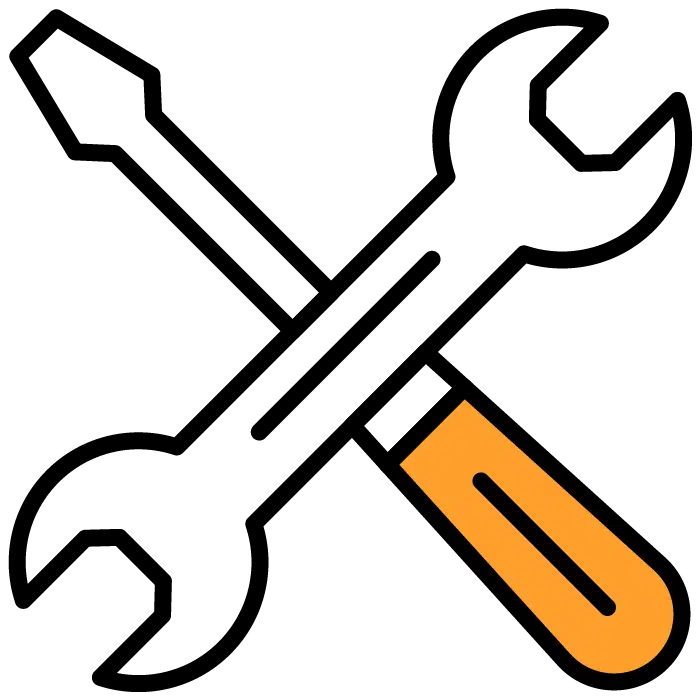
Hiring the right candidate can make or break your team. 5 Science-Based Candidate Assessment Strategies
Think about it: would you build a house with just a hammer? Of course not. You'd use a full toolkit. In the same way, relying on multiple assessment techniques will help you make better hiring decisions.
We'll cover five key tools: structured interviews, job knowledge tests, empirically keyed biodata, work sample tests, and general mental ability tests. Each of these has been scientifically proven to predict job performance effectively.
Imagine you're hiring a chef. You wouldn't just ask them about recipes (structured interviews) but also taste their food (work sample tests) and check their cooking background (Performance based Interviews).
By using all these tools, you can consistently hire top talent, leading to better performance and less turnover. Let's dive into how you can apply these methods to build a strong team.
Structured Interviews
What They Are: Structured interviews involve asking all candidates the same set of predetermined questions. This standardizes the interview process, ensuring that each candidate is evaluated on the same criteria.
Why They Work: Imagine you're running a cooking competition. If each contestant is asked to cook a different dish, it would be tough to compare them fairly. Structured interviews are like asking each contestant to cook the same dish, allowing you to judge them on the same factors. This method promotes consistency and fairness, reducing biases that might arise from an unstructured approach.
How to Implement: Start by identifying the core competencies and skills required for the job. For instance, if you're hiring a sales manager, you might focus on competencies like communication, negotiation, and leadership. Develop a set of questions that target these areas. You can use situational questions ("Tell me about a time when..."), behavioral questions ("How do you handle..."), and technical questions specific to the job.
Example: Let's say you're hiring a customer service manager. A structured interview might include questions like, "Can you describe a time when you resolved a difficult customer issue?" or "How do you train new team members to ensure high customer satisfaction?" By asking each candidate the same questions, you can directly compare their responses and assess their suitability based on consistent criteria.
Support from Science: Research strongly supports the effectiveness of structured interviews. According to Sackett et al. (2022), structured interviews have a validity estimate (ρ) of 0.42 with a standard deviation (SD) of 0.19, and a lower 80% credibility value of 0.18. This means that structured interviews are quite reliable in predicting job performance compared to other methods. By standardizing the interview process, you not only ensure fairness and consistency but also significantly increase the likelihood of selecting the best candidate for the role.

Job Knowledge Tests & Work Sample Tests
Combining job knowledge tests with work sample tests creates a comprehensive evaluation process that assesses both theoretical knowledge and practical skills. Job knowledge tests verify that candidates understand the critical areas of the job, ensuring they have the necessary expertise. Work sample tests then allow candidates to demonstrate this knowledge in real-world scenarios, confirming their ability to apply what they know effectively. This combination ensures a thorough assessment, where candidates not only "talk the talk" but also "walk the walk," leading to higher confidence in their ability to perform well on the job.
Job Knowledge Tests
What They Are: Job knowledge tests are designed to measure a candidate's understanding and expertise in the specific tasks and responsibilities required for the job.
Why They Work: Imagine you're hiring a pilot. You wouldn't just want to know if they can talk about flying; you'd want to see if they know how to actually operate a plane. Job knowledge tests are like asking a pilot to explain the instrument panel and demonstrate an emergency landing procedure. They ensure that the candidate has the practical knowledge needed for the job, which translates directly to their ability to perform effectively.
How to Implement: Start by identifying the critical knowledge areas for the role. If you're hiring an accountant, for example, you might focus on financial regulations, tax codes, and software proficiency. Develop a set of questions or problems that test these areas. You can use written tests, practical exercises, or even software simulations to evaluate candidates.
Example: Let’s say you’re hiring a project manager for a construction company. A job knowledge test might include questions about project scheduling, cost estimation, safety regulations, and familiarity with project management software. You could give them a scenario where they need to create a project timeline and budget for a hypothetical project. This way, you can see their knowledge in action and ensure they’re equipped to handle the real-life demands of the job.
Support from Science: Research supports the effectiveness of job knowledge tests. According to Sackett et al. (2022), job knowledge tests have a validity estimate (ρ) of 0.40 with a standard deviation (SD) of 0.13, and a lower 80% credibility value of 0.23. This indicates a strong correlation between test scores and actual job performance, particularly in technical and professional roles. By integrating job knowledge tests into your hiring process, you're not just guessing if a candidate can do the job—you’re verifying it. This method helps filter out those who might "talk the talk” but can't “walk the walk", ensuring you hire someone who is both competent and confident.
Work Sample Tests
What They Are: Work sample tests involve candidates performing tasks that simulate actual job duties. These tasks are designed to closely mimic the activities and responsibilities they would handle if hired.
Why They Work: Work sample tests are like taking a car for a test drive before buying it. They provide a realistic preview of how candidates will perform on the job, allowing you to see their skills in action. This method is especially useful for roles requiring specific technical skills or hands-on abilities.
How to Implement: Start by identifying the key tasks and responsibilities of the job. Then, design work sample tests that accurately reflect these activities. For example, if you’re hiring a software developer, you might ask candidates to write and debug a piece of code. For a customer service role, you might simulate a customer interaction and assess how candidates handle the situation.
Example: Suppose you're hiring an electrician. A work sample test could involve candidates wiring a simple circuit based on provided specifications. This allows you to directly observe their technical skills, problem-solving abilities, and adherence to safety protocols.
Support from Science: Research underscores the effectiveness of work sample tests in predicting job performance. According to Sackett et al. (2022), work sample tests have a validity estimate (ρ) of 0.33 with a standard deviation (SD) of 0.09, and a lower 80% credibility value of 0.21. This indicates a solid correlation between performance on work sample tests and actual job performance. Moreover, these tests provide a fair and objective way to assess candidates' abilities, reducing biases that might occur in other forms of evaluation.
Work sample tests also tend to be well-received by candidates because they provide a clear understanding of job expectations and allow them to demonstrate their skills in a practical setting. This can enhance the candidate experience and improve the overall hiring process.
Incorporating work sample tests into your hiring process ensures that you’re making informed decisions based on candidates' demonstrated abilities rather than just their interview responses or resumes. This approach helps you identify top performers who are truly capable of excelling in the role.
Performance-Based Interviewing (Empirically Keyed Biodata)
What It Is: Empirically keyed biodata, or what we often refer to as “Performance-Based Interviewing” a term famously coined by Lou Adler, involves collecting biographical data from candidates, such as past experiences and achievements, and using statistical methods to link these data points to job performance.
The Topgrading Methodology developed by Brad and Geoff Smart refers to this as a Career History interview. We prefer a hybrid of these commonly known techniques that leverages the structure of a Career History interview and the depth of a Performance-Based Interviewing technique.
Why It Works: This method is like looking at a candidate's resume under a microscope. By analyzing detailed historical data, you can identify patterns and traits that predict future job success. It goes beyond what candidates say in an interview, providing a data-driven way to assess their potential.
How to Implement: Start by developing a biodata questionnaire tailored to the job. This questionnaire should include questions about past experiences, educational background, significant achievements, and other relevant biographical information. The key is to use statistical analysis to identify which of these factors are most strongly linked to successful job performance in your specific context.
Example: Suppose you're hiring a sales manager. Your biodata questionnaire might include questions about previous sales targets met, leadership roles held, and specific strategies used to close deals. By analyzing the responses from your top-performing sales managers, you can identify which experiences and traits are most predictive of success in this role.
Support from Science: Research supports the use of empirically keyed biodata in predicting job performance. According to Sackett et al. (2022), empirically keyed biodata has a validity estimate (ρ) of 0.38 with a standard deviation (SD) of 0.09, and a lower 80% credibility value of 0.26. This indicates a strong relationship between biodata scores and job performance. By incorporating this method into your hiring process, you gain a more objective and reliable way to identify candidates who have a proven track record of success, ensuring you hire individuals who are not only qualified but likely to excel in their roles.

General Mental Ability (GMA) Tests
How to Implement: Implementing GMA tests involves selecting standardized cognitive ability tests that are validated and reliable. These tests typically consist of multiple-choice questions that cover various aspects of cognitive functioning. For instance, you might use tests that measure verbal reasoning, numerical ability, and abstract thinking. It’s important to ensure that the tests you choose are appropriate for the level of the job and the specific skills required.
Example: Suppose you're hiring for an IT support specialist. A GMA test might include questions that assess logical reasoning, pattern recognition, and problem-solving abilities. These skills are essential for diagnosing technical issues and finding effective solutions. By using a GMA test, you can identify candidates who have the cognitive ability to excel in this role.
Support from Science: Research shows that GMA tests are strong predictors of job performance. According to Sackett et al. (2022), GMA tests have a validity estimate (ρ) of 0.31 with a standard deviation (SD) of 0.14, and a lower 80% credibility value of 0.13. This means that GMA tests have a solid correlation with job performance across various fields. By incorporating GMA tests into your hiring process, you can more accurately identify candidates who possess the intellectual capabilities necessary for success, ensuring you select individuals who can learn quickly, adapt to new challenges, and contribute effectively to your organization.

Designing a 6-Step (7-14 Day) Hiring Process Using Five Science based candidate assessment Techniques
Creating a streamlined hiring process that leverages multiple assessment techniques can ensure you select the best candidates while keeping them engaged. Here's how an organization might design a comprehensive hiring process within 7-14 days using structured interviews, job knowledge tests, work sample tests, empirically keyed biodata, and GMA tests, all managed through Discovered’s platform.

Step 1 (Day 1-2): Initial Screening and Structured Interviews
- What Happens: Start with a brief initial screening call to verify basic qualifications and interests. Follow this with a structured interview using a standardized set of questions.
- How Discovered Can Help: Use Discovered's Applicant Tracking System (ATS) to automate the initial screening and schedule structured interviews. The system ensures that all candidates are evaluated on the same criteria, promoting fairness and consistency.
- Candidate Engagement: Inform candidates that this initial step ensures a fair and unbiased evaluation. Highlight that structured interviews help them showcase their skills consistently against the job requirements.
- Benefits: Quickly filter out unqualified candidates while maintaining fairness and consistency.
Step 2 (Day 3-5): Combined Job Knowledge and GMA Tests
- What Happens: Candidates who pass the initial screening are invited to complete a combined job knowledge and GMA test. This assesses both their cognitive abilities and specific job-related knowledge.
- How Discovered Can Help: Leverage Discovered's Employee Assessment Software to administer and manage the tests. The platform integrates both job knowledge and GMA tests seamlessly.
- Candidate Engagement: Explain that this step helps identify candidates with both the intellectual capabilities and the job-specific knowledge needed to excel. Offer feedback on their performance to keep them informed and motivated.
- Benefits: Efficiently assess theoretical knowledge and cognitive skills, ensuring candidates are well-rounded.
Step 3 (Day 6-8): Work Sample Tests
- What Happens: Invite candidates who perform well on the combined tests to complete a work sample test that simulates actual job duties.
- How Discovered Can Help: Use Discovered's Custom Skill Tests to create realistic job simulations. The platform allows for easy customization and administration of work sample tests.
- Candidate Engagement: Describe this step as an opportunity for candidates to experience real job scenarios, giving them a chance to demonstrate their practical skills. Highlight how this practical test can be beneficial for them to understand job expectations.
- Benefits: Validate candidates' ability to apply their knowledge in real-world scenarios, ensuring practical competence.
Step 4 (Day 9-10): Performance-Based Interviewing (Empirically Keyed Biodata)
- What Happens: Conduct in-depth interviews focusing on past experiences and achievements, using a structured format to gather biodata.
- How Discovered Can Help: Utilize Discovered's Interview Guides to structure and standardize these in-depth interviews. The platform helps gather and analyze biodata effectively.
- Candidate Engagement: Inform candidates that this interview helps to understand their career journey and achievements, allowing them to highlight their most significant contributions. Show how these insights can benefit their career development.
- Benefits: Identify patterns and traits linked to job success, providing a data-driven assessment of potential.
Step 5 (Day 11-12): Final Structured Interviews and Candidate Scorecards
- What Happens: Conduct final structured interviews using a set of predetermined questions targeting core competencies and job-specific skills. Use candidate scorecards to ensure consistent and objective evaluation.
- How Discovered Can Help: Discovered’s Candidate Scorecards feature ensures that all interviewers evaluate candidates based on the same criteria, promoting objective and consistent assessments.
- Candidate Engagement: Explain that this step ensures a comprehensive evaluation and allows for a final comparison based on consistent criteria. Highlight the fairness and thoroughness of the process.
- Benefits: Promote consistency and fairness in the final evaluation, reducing biases and enabling direct comparison.
Step 6 (Day 13-14): Final Evaluation and Decision
- What Happens: Gather and review all assessment data to make a final hiring decision.
- How Discovered Can Help: Use Discovered’s Workflow Management to consolidate all assessment results and facilitate collaboration among hiring team members.
- Candidate Engagement: Keep candidates informed about the timeline and next steps. Once a decision is made, provide detailed feedback to both successful and unsuccessful candidates, highlighting their strengths and areas for improvement.
- Benefits: Ensure a thorough and holistic assessment of each candidate, leading to confident hiring decisions.
By leveraging Discovered’s advanced tools throughout each step, organizations can maintain a smooth and efficient hiring process, ensuring that candidates stay engaged and motivated. This approach not only enhances the candidate experience but also ensures that the best talent is identified and selected swiftly.














